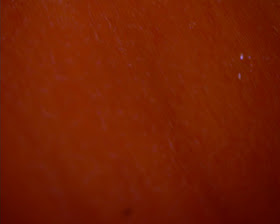
Here's one at 200x.

The BioniCam is a serviceable and very inexpensive device for getting magnified photos, you just have to acknowledge its limitations. It's really designed for photographing objects that are held perfectly still on a flat surface where you can take the time to focus properly. Despite the way it is advertised, it's not the kind of thing you would carry around with you on a hike for quick and easy photos.
The thing that concerns me about it is the outrageous magnification claims. The professional-grade microscopes I've used have to get to very short working distances to get that sort of magnification (as in, a couple of millimeters at most), because otherwise diffraction effects cause a lot of blurring. Short-working-distance objectives are expensive to make, though. So instruments like this have long working distances, and the image quality at high magnification suffers. They'd be better off dialing back to maybe 50X. You run into the same thing with cheap telescopes - they claim huge magnifications, because it sounds impressive, but it turns out that their objective is so small that all you are seeing is a highly-magnified blur.
ReplyDeleteAs far as I can tell, while a lot of companies try to use specialty features to *sell* optical instruments, what you are actually *paying* for is the glass (and, to a lesser extent, the lighting). So cheap optics just aren't going to deliver the high magnifications, because they can't have good enough glass.
Ovelduo - A pair of two-minute eggs.
Tim, thanks for the visit and the comment. I'm not sure I believe any of the claims on the thing. The ergonomics are terrible as I might chronicle later. What have discovered is that I really do want a tool for this kind of photography. I'm going to start shopping for a good one now and save my cash (as Dave Ramsey would tell me to do) and buy one.
ReplyDeleteI'm looking forward to doing some microbe-blogging.
:-)
Incidentally, Alex Wild has a lot to say about the difficulties of photography at high magnifications. One thing that I think is interesting to note, is that he has a number of pictures that are nominally "5X" which any normal person would consider greatly magnified. Alex comments that this magnification is already very difficult to hand-hold. This not only shows what you can get away with at fairly moderate magnifications, it also indicates just how divorced from reality a "400x" hand-held microscope really is.
ReplyDeleteTim, you are an absolute cornucopia of knowledge. You rock!
ReplyDeleteAs for the lens - WANT!